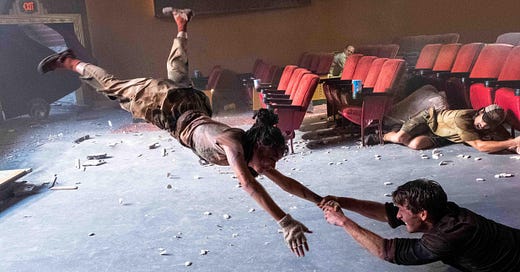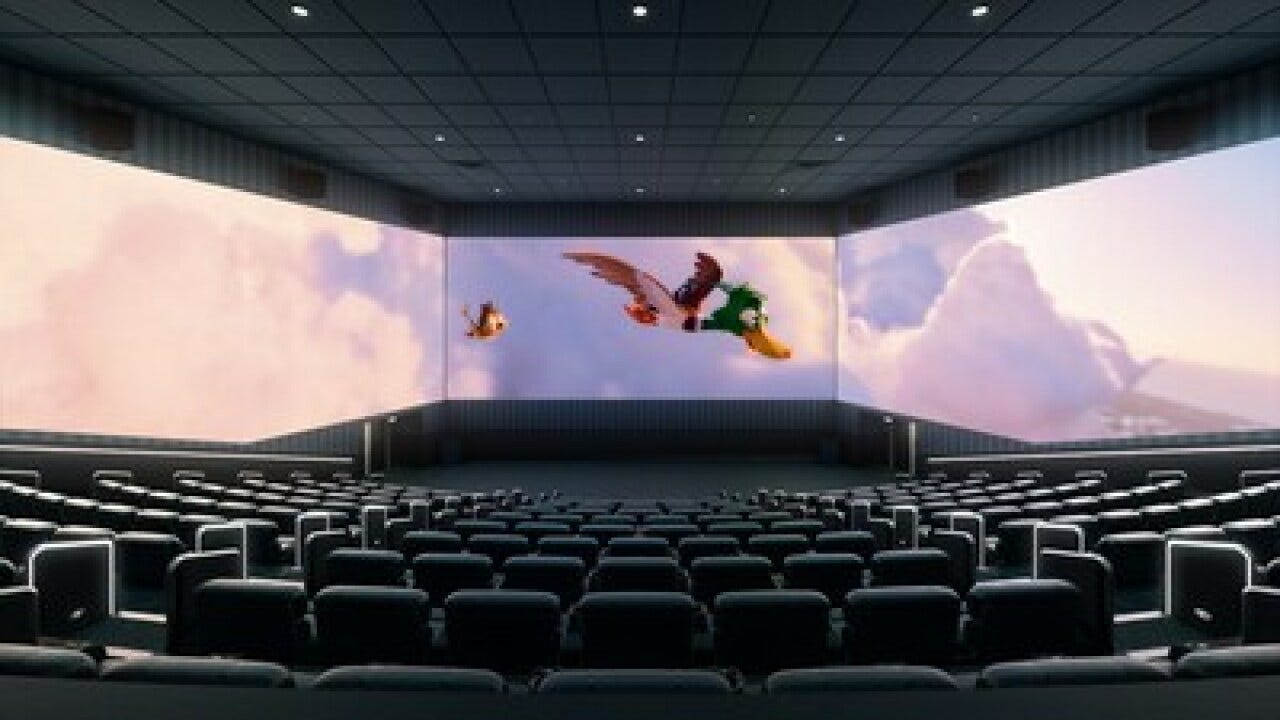There’s a lot of love for 1996’s Twister that owes more to nostalgia than actual quality. Those of us who were teenagers when Jan de Bont’s action adventure hit the big screen remember an intense, visceral experience. Rewatching it recently, I was reminded that while it is, indeed, quite a ride, it’s also saddled with thin characters and a threadbare plot. It’s more demo reel than movie, with spectacle taking precedence over story.
In that sense, it’s a lot like Top Gun from a decade prior, a sleek film that delivers surface pleasures but little more. And, like Top Gun, it’s now getting a sequel years after its release, hoping to recapture the affection for its predecessor and introduce a new audience to its particular brand of thrills.
That comparison is fairly apt, as Twisters boasts a “story by” credit from Top Gun: Maverick director Joseph Kosinski and counts one of Maverick’s supporting cast members as its lead. And while Twisters can’t quite capture the calculated thrills of that 2022 smash, it’s another legacy sequel that improves on what came before by marrying a more thoughtful story and genuine emotion to its scenes of chaos.
Unlike Maverick, which pinned its hopes on the return of Tom Cruise, Twisters is almost completely disconnected from Jan de Bont’s film, aside from a few visual references and Easter eggs, such as the “Dorothy” system that was the hook of the 1996 movie’s story. That’s probably wise; Bill Paxton passed away several years ago and Helen Hunt has been candid about the torture of making the movie. And besides, apologies to Paxton, Hunt and the late Philip Seymour Hoffman, but those characters were not what you would call “beloved,” “developed” or “characters.” The tornadoes were the stars.
Instead, Twisters centers its story on Kate Carter (Daisy Edgar-Jones), an analyst with the National Weather Service who, years earlier, was a Ph.D. student with a plan for disrupting tornadoes. When her team was tragically lost in the field, she settled for a desk job but is called back to Oklahoma when old friend Javi (Anthony Ramos) asks for her help testing new radar during a once-in-a-lifetime tornado outbreak. Kate heads back to tornado alley to help the team, and quickly crosses paths with “tornado wrangler” Tyler Owens (Glen Powell), a YouTube influencer who treats tornadoes like his own personal rodeos.
It’s an interesting inversion of the first film’s dynamic, putting the hero on the side of the corporate tech heads and in competition with the scrappier team. But where Twister made a hard delineation between its good and bad guys, the sequel gives them slightly more depth. There’s more going on with Javi’s team than initially meets the eye, and it’s quickly clear that helping others isn’t their main goal. And if you think they hired Powell just to be a douchebag villain, you might need to watch more movies.
That’s good because, honestly, Kate and Javi are kind of drips. In the prologue, they’re energetic college students gleefully putting themselves in the path of danger all in the name of science. There’s a fun energy and likability to the characters, and it helps anchor the emotional stakes of the film’s opening, but it’s gone when we catch up with them down the road. While I understand that the events of that scene are the reasons why Kate is a bit more reserved and dour five years later, it makes the first act a bit of a slog, especially as the film dampens the charisma of Hamilton’s Ramos, making Javi a money-chasing corporate shill.
The film’s energy ramps up when Tyler and his crew burst onto the scene, tearing up the mud in their pickup trucks, blasting country music, and shilling merch. Where Kate is timid and calculating, Tyler and his team rip into their first tornado and blast fireworks up its ass. Powell, who so recently proved himself a charisma machine in last month’s Hit Man, instantly energizes the film, and the instant he starts flirting with Kate – and finds someone just as in awe of tornadoes as he is – you know it’s not going to be long before she lets her hair down, ditches the corporate uniform for a T-shirt and finds the crazies might just also be kindred spirits.
The original Twister only exists because producer Steven Spielberg discovered computer artists could create a convincing tornado and asked that a film be built around it. The story put a divorcing couple still pining for each other at its core and structured a series of storms to throw at them. It’s not a deep film and, let’s be honest, not an especially good one, but the pleasures it delivers derive from its nonstop nature, limiting its scope to one day and not letting too long pass between storms. The characters aren’t memorable and the plot is non-existent, but there’s a reason electronics stores made it the go-to movie for demoing new TVs and sound systems.
Twisters’ script is slightly more thoughtful. Oh, the story is still structured around a series of tornadoes that grow in ferocity as the plot beats dictate. But stretching the timeframe out to several days instead of a few hours allows Mark Smith’s script to build more tension between the characters, delve into the fear and awe that fuel the chase, and construct a fairly effective romance between Kate and Tyler. Where Twister paid lip service to the idea that Bill Paxton and Helen Hunt’s characters were trying to further science, Twisters admires Kate’s educational background and spends more time reminding the audience that while tornadoes deliver thrills, they also wreak destruction and take lives. It’s still first and foremost an adventure movie but, like Top Gun: Maverick before it, it puts in some effort to deliver a real and emotional – if familiar – story.
While much of the story regarding Javi’s team is rote and suffers from some pacing issues, the focus on how rich land developers exploit tragedy is an interesting addition. And it’s so obvious that Kate is going to leave the boring greedy folk and take up with the adrenaline-chasing but good-hearted storm chasers that’s it’s a relief when she and Tyler quickly strike up a friendship. I’m still not totally sold on Powell’s ability to do anything but charm and play cute good ol’ boys, but that’s all he’s asked to do here and he does it well. Tyler might be loud and have no problem exploiting his fame, but Powell easily sells that there’s someone smarter and more compassionate behind the influencer facade, and the scenes where he and Kate flirt – including an extended detour to see her mother (Maura Tierney) are the film’s strongest non-tornado things. Powell and Edgar-Jones have chemistry, and the film structures their flirtation around their mutual love and fear for tornadoes, to the extent where taking shelter in an abandoned pool is basically foreplay and driving a truck into the heart of a cyclone counts as consummation. The film so foregrounds their budding relationship – including a race to the airport scene near the end – that it’s a bit shocking that there’s never a kiss to seal the deal. Again, it’s no Tom Hanks and Meg Ryan, but I believe these actors like each other more than Helen Hunt and Bill Paxton (who reportedly hated each other).
Director Lee Isaac Chung was a curious choice to helm this and I’ll admit that I was initially dismayed to see the person between the tender and emotionally rich Minari moving on to a summer sequel. But, like Michael Sarnoski, who went from the transcendent Pig to A Quiet Place: Day One, Chung proves he can make the transition to big-budget filmmaking without losing his personal touch. It’s not just that he seems interested in treating his characters as more than tornado fodder; Chung has a natural feel for how to shoot the Midwest and the rolling countryside. He understands the energy of sending his characters to a rodeo or the power of having a funnel cloud form in the background of a Little League game. With his Arkansas background, Chung understands the power of killer storms and treats them as more than special effect set pieces. There’s a scene where Kate and Tyler explain how tornadoes form and it’s illustrated with a visual poetry that respects the beauty and danger of nature, and during one shelter from a vicious twister, Chung holds tight on the actors’ faces, letting their urgency shift to terror. He never lets us forget that these storms are terrifying – that’s the appeal.
Chung lacks De Bont’s knack for creating immersive, visceral action sequences; there’s nothing as adrenaline-pumping as the chase in the first movie where Paxton and Hunt had to dart around falling farm machinery. But there are several intense, well-done moments with some striking visuals, such as the aforementioned shelter in an empty pool, a tornado charging through a refinery and catching fire, and an especially powerful climax set in a small-town cinema. The tornados are, obviously, much better rendered than they were nearly 30 years ago, although it’s easy to forget that Twister incorporated several practical effects, and those are missing here.
It’s turned into a pretty satisfying summer, quality-wise. And Twisters is, like A Quiet Place: Day One, a nice little surprise as a piece of blockbuster product that doesn’t ask its director to sacrifice all their personality. It doesn’t quite hit like the Finger of God, but it stays far from the Suck Zone.
A quick note on format…
I had the privilege of previewing Twisters in Michigan’s first ScreenX theater, which opens this weekend at the MJR Waterford. ScreenX is a technology that offers a “270-degree” viewing experience in select scenes, with screens on three walls of the theater. Basically, the main film plays on the center scene, but supplemental imagery is projected on the side walls, with the idea of creating a more immersive experience. (Here’s a video explanation).
I’ll be honest – while I didn’t hate the experience, I doubt I’d pay extra or drive an hour out of my way to see a film in Screen X again. While the images on the sides of the screen didn’t completely distract me, I wouldn’t call it exactly immersive (especially since there are still gaps in the corners of the theater on either side of the main screen). For the most part, the images on either side just felt like surrounding material that would have been out of view from the camera, although at times the images on the sides had movement when the main screen didn’t or didn’t completely align.
It’s also worth noting that ScreenX is done in post-production; directors don’t make movies with ScreenX in mind. And a simple rule to remember with movies is that what’s in frame – and what’s left out – is usually by choice. Expanding it leaves an image that isn’t intended by the directors and, in my opinion, it detracts from what’s on screen. I wasn’t distracted too often by Twisters in this format, but I’d still much prefer a good old Imax screen.






